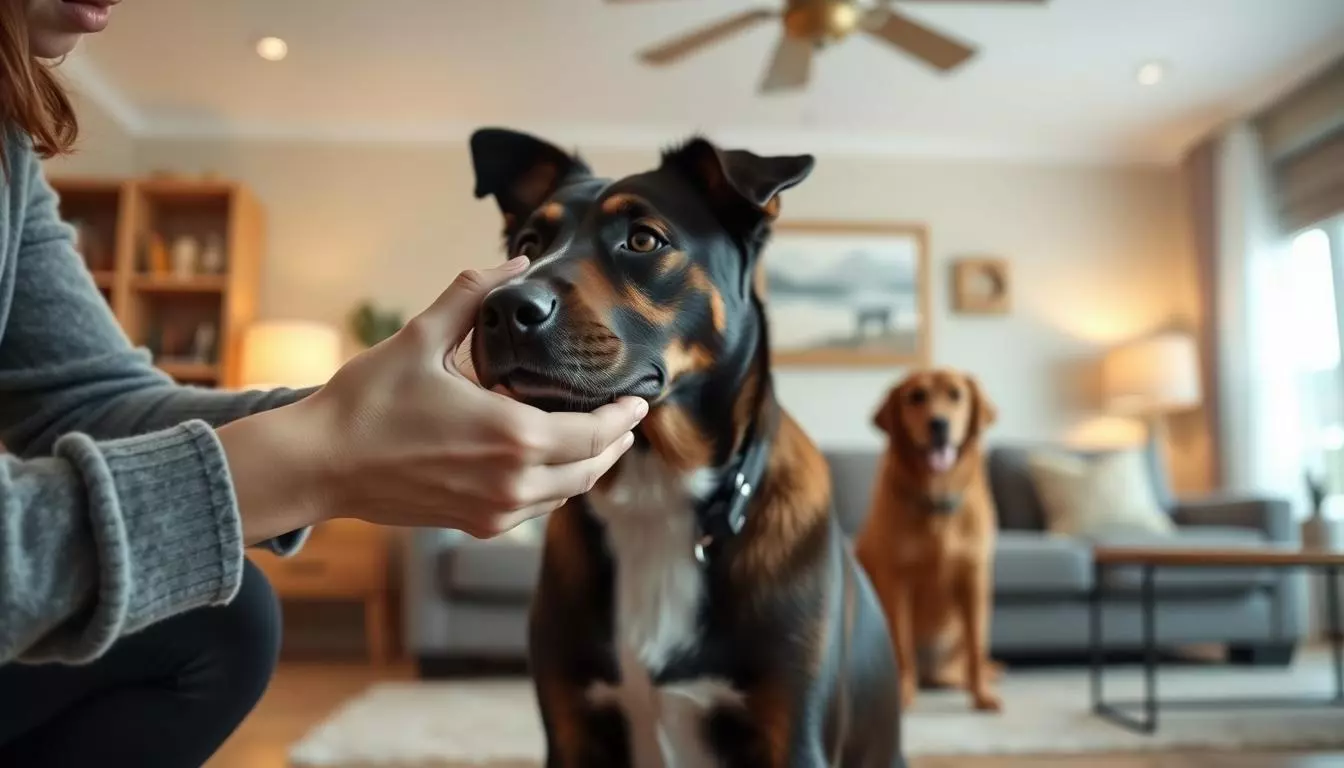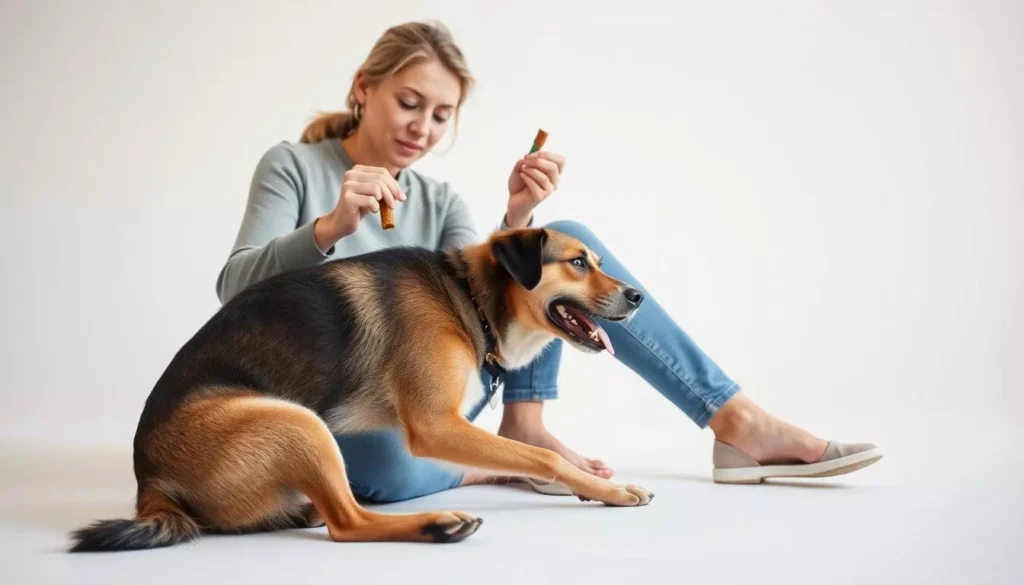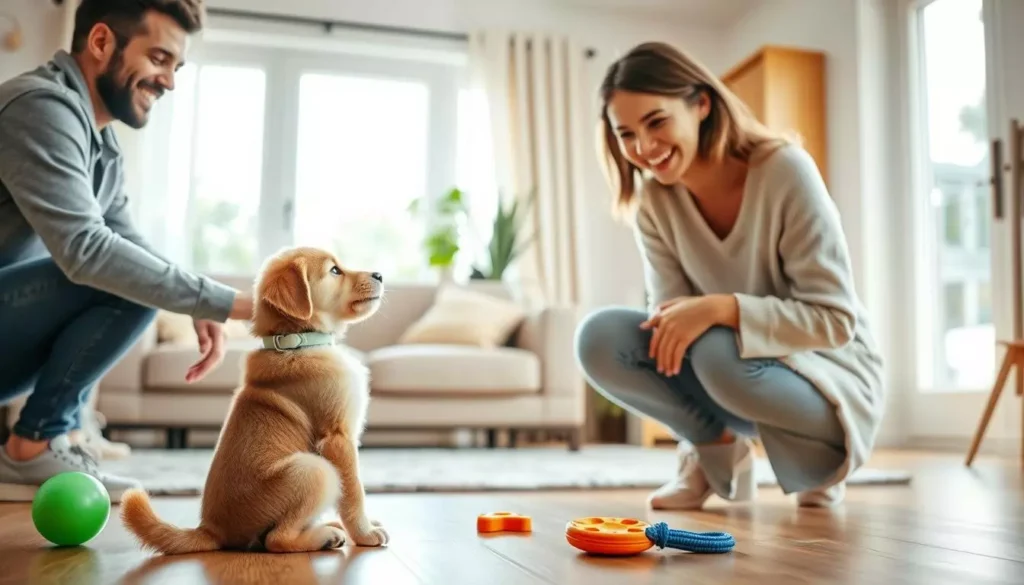Being a dog owner can be incredibly rewarding, but it also comes with challenges. When your dog's behavior turns aggressive, it can be very scary. I remember when my dog, in her excitement, nipped at my daughter's hand. It was a shocking moment that left us both upset.
But, I found simple and effective ways to stop dog biting. In this article, I'll share how to understand dog biting behavior. I'll also give you strategies to improve your dog's behavior. This way, we can all have safer and happier times together.
Key Takeaways
- Understanding the triggers behind dog biting can lead to more effective techniques to stop dog biting.
- Recognizing early warning signs is crucial for preventing harmful incidents.
- Implementing bite inhibition techniques can significantly improve interactions.
- Positive reinforcement plays a key role in shaping better behavior in dogs.
- Creating a safe environment reduces the likelihood of biting episodes.
- Training and socialization are essential for a well-adjusted dog.
Understanding Dog Biting Behavior
Dog biting behavior often comes from emotional and environmental factors. It's key to understand the signs and emotions behind these actions. Dogs usually give warnings before biting, so watching their body language is crucial.
I've seen dogs bite when they feel threatened, too excited, or in pain. Knowing why dogs bite helps me act early to stop aggression. I watch for changes in posture, tail, and vocalizations to manage biting behavior.
Spotting early warning signs can lower the risk of bites. A dog's mood greatly affects its actions. With awareness and learning, owners can create a safe space for their pets and handle aggression well.
Why Dogs Bite: Common Triggers
Understanding why dogs bite is key to preventing incidents. Fear-based aggression is a common reason. Dogs may feel scared or threatened by new places, people, or other dogs. This fear can lead to defensive bites.
Excitement-related biting is another factor. It happens during play, especially with young dogs. Their excitement can cause hard nips or playful bites, which can be startling and painful.
To manage these behaviors, it's crucial to know what triggers dog bites. Situations that make a dog feel trapped or stressed can make them more defensive. Being aware of what scares or excites your dog helps create a safer space for everyone.
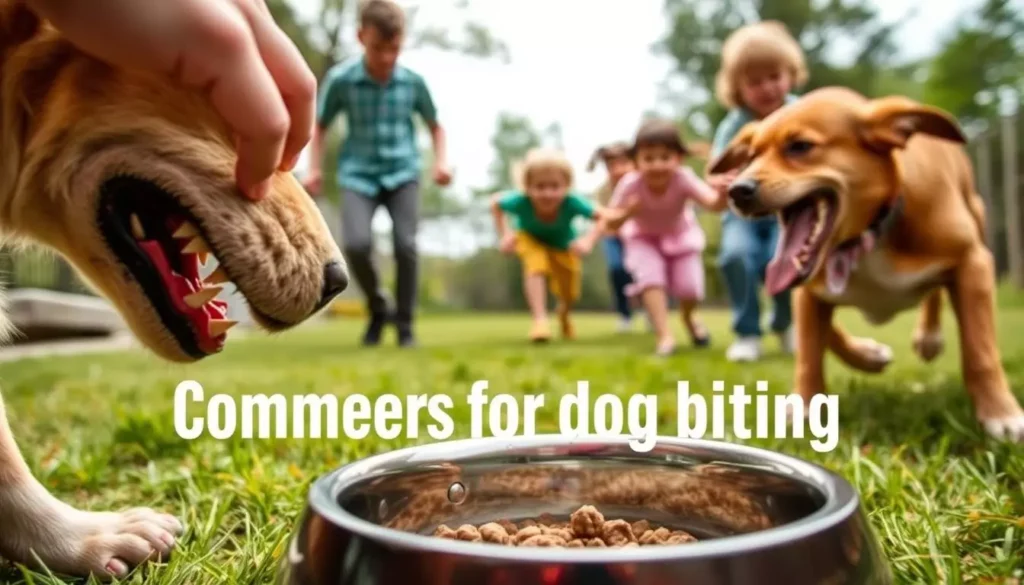
| Trigger Type | Description |
|---|---|
| Fear-Based Aggression | Occurs when a dog feels threatened or scared, often leading to defensive biting. |
| Excitement-Related Biting | Common among younger dogs during playtime, this biting stems from overexcitement. |
| Unfamiliar Environments | New surroundings can cause anxiety, leading to a potential biting response. |
| Sudden Movements or Loud Noises | Unexpected stimuli can trigger a fear response, resulting in biting to protect themselves. |
Decoding Dog Bite Warning Signs
It's important to know how your dog feels through their body language. Dogs show their feelings through posture and movement. Signs of aggression include raised hackles, ears pinned back, and big pupils.
Growling or lip licking are also warning signs. These actions usually mean the dog is uncomfortable or wants space. As a dog owner, it's my job to notice these signs and act right.
Understanding dog body language helps me talk better with my dog. It makes our home safer. Knowing when a dog might get aggressive helps me stop a bite before it happens. This keeps everyone safe.
How to Stop a Dog from Biting
Stopping a dog from biting is a tough but rewarding task. Using the right techniques can make everyone safer. Bite inhibition training and positive reinforcement are key to reducing biting.
Implementing Bite Inhibition Techniques
Bite inhibition training teaches dogs to control their bite. It's like how puppies learn from each other. When my dog bites too hard, I say a high-pitched 'yelp' to show them it's wrong.
Not paying attention to them for a bit also teaches them. It helps them learn to play without biting.
Using Positive Reinforcement to Discourage Biting
Positive reinforcement rewards dogs for good behavior. When my dog plays nicely, I praise them or give treats. This makes them want to do it again.
By always rewarding good behavior, we build good habits. Being consistent is important. It helps my dog know what's expected of them in a positive way.
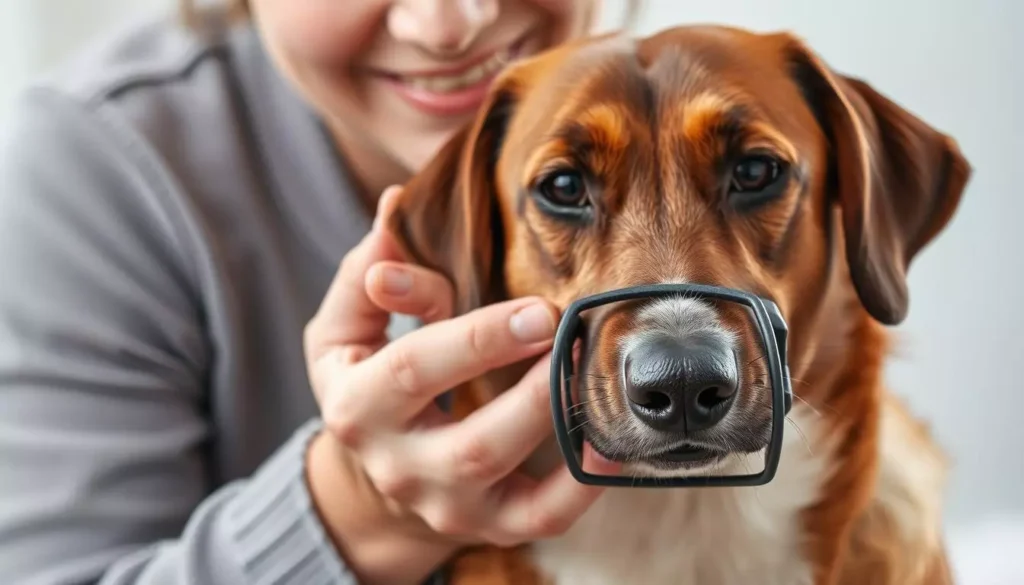
Managing Dog Behavior Effectively
Managing dog behavior is more than just training. It's about creating a safe space that reduces stress and boosts comfort. A well-organized environment helps dogs behave better and feel less anxious.
Creating a Safe Environment
To make a safe space for your dog, start by making them feel secure. This means having a quiet area, using barriers to block off scary spots, and keeping things safe. Here are some tips:
- Set up a quiet zone with toys and bedding your dog knows.
- Keep loud noises away by closing windows or using soundproofing.
- Give your dog fun activities to keep their mind busy.
Identifying Stressors and Triggers
It's key to know what stresses your dog out. By spotting triggers, you can manage their stress better. Common stressors include:
| Trigger | Possible Solutions |
|---|---|
| Unfamiliar visitors | Introduce them slowly and use treats to make it positive. |
| Other dogs during walks | Do controlled introductions in a neutral place to help social skills. |
| Sudden loud noises | Avoid busy or noisy areas during walks. |
By tackling stressors early, you can make your dog's life more peaceful.
Training Strategies to Prevent Biting
Teaching your dog good habits is key to stopping biting. Learning basic commands like "sit," "stay," and "leave it" helps you control them. It also tells them what you expect. This way, your dog feels more confident and less likely to bite.
Essential Commands for Control
Commands are important for keeping control in different situations. I've seen that using them often helps dogs understand better. This means they can handle stress without biting.
Make sure to use these commands in your training. It helps avoid bad behavior.
Importance of Socialization and Exposure
Socializing puppies is crucial for their growth. They need to meet different people, pets, and places. This helps them handle excitement and stress without biting.
Visiting dog parks or meeting friendly animals is good. It teaches them to react positively to new things.
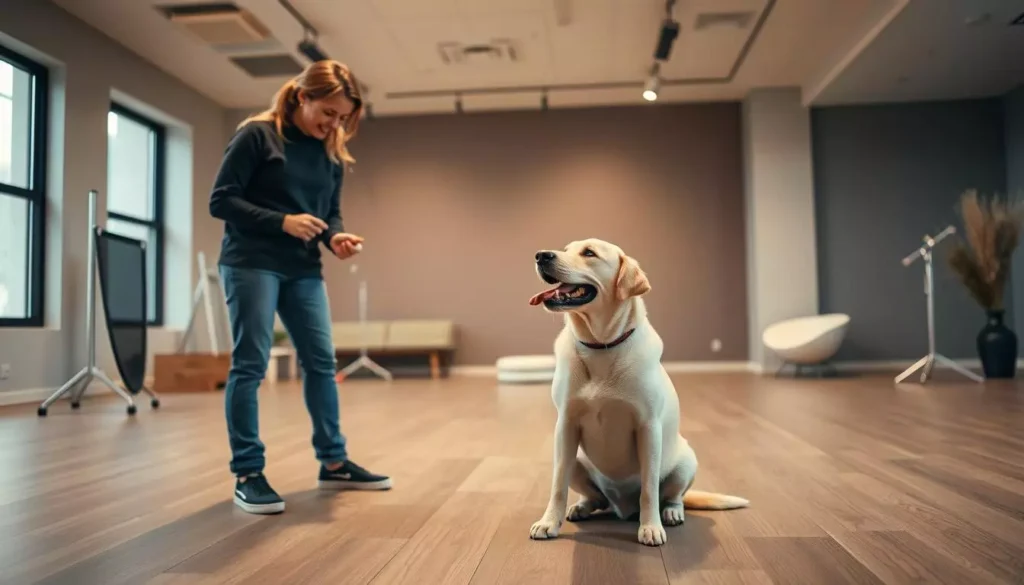
Training and socializing together helps dogs adjust to new situations. This approach can greatly lower the chance of biting. It makes your pet well-behaved and confident.
Puppy Biting: What to Expect and How to Cope
As a puppy owner, I've learned that dealing with puppy biting can be tough. Puppies use their mouths to explore, leading to nipping and biting. This is a normal part of their growth and can be managed with the right approach.
Managing puppy nipping means understanding why they do it and using the right training. It's key to set clear rules and give them safe chew toys. This helps teach them what's okay to bite and chew.
Dealing with biting puppies needs patience and consistency. Knowing this stage is part of their learning helps me manage my expectations. With time, training, and positive reinforcement, my puppy will learn to control their biting.
Keeping My Dog Calm During Exciting Situations
When my dog gets excited, I need to calm them down to avoid bad behavior. I use several ways to help them stay calm, even when things get busy. One good method is using calm signals like soft voices and relaxed body language.
Structured activities help a lot too. Taking my dog for fast walks or training sessions helps them use up their energy. Playing with interactive toys also keeps them calm and focused.
Being consistent is key. I always use the same calming techniques to make my dog feel secure. This way, I can keep my dog calm and happy, making our time together better.
Intervening in Playtime: Healthy Boundaries
Playtime is vital for dogs as it lets them socialize and get exercise. It's important to set boundaries to keep play safe and fun for everyone. If play gets too rough, it can lead to biting or aggression, so we need to act fast.
Redirecting to Chew Toys
Redirecting biting behavior keeps dogs safe and teaches them right ways to play. When my dog gets too rough, I step in right away. I give them chew toys to play with, which keeps them from biting the wrong things.
This method shows them that chew toys are the right thing to chew on. Here are some good things about redirecting biting:
- It teaches them what's okay and what's not.
- It helps them play safely with other dogs.
- It helps them learn good play habits.
- It lowers the chance of them biting in the future.
Chew toys keep my dog happy and busy. When I step in at the right time, my dog can play without worrying about getting too rough.
| Tip | Description |
|---|---|
| Observe Play Intensity | Watch how excited your dog gets to stop biting before it starts. |
| Use Chew Toys | Give them different chew toys to play with, which helps them learn good habits. |
| Establish Rules | Make it clear what's okay and what's not during playtime. |
| Positive Reinforcement | Give your dog treats when they play with toys instead of other dogs. |
Setting boundaries in dog play is a smart move that makes playtime fun and safe. By catching and changing bad behavior, I help create a great play space for my dog.
Professional Help: When to Seek Assistance
At times, my dog's biting might be too much for me to handle alone. That's when I know I need to seek dog training help. Certified trainers and specialists can create a plan just for my dog. They help address the reasons behind the biting, making our lives better.
Finding a Certified Dog Trainer
I look for trainers who use positive methods. This builds trust and helps my dog learn without fear. It's important to find trainers with verified credentials from trusted organizations.
Understanding Behavioral Specialists
Behavioral specialists are key for complex biting issues. They know animal behavior well and find what triggers the biting. Working with them helps me understand my dog's behavior better, leading to lasting changes.
Conclusion
Understanding and managing dog biting behavior is a journey. It needs commitment and patience from me as a dog owner. By using effective strategies, I can improve my dog’s behavior and strengthen our bond.
Creating a safe environment and identifying triggers are crucial. Consistent training strategies also play a big role. These steps help in managing dog behavior.
This approach not only keeps others safe but also makes my pet happier and healthier. If I feel overwhelmed, getting help from experts is a good idea. They offer valuable insights and guidance.
Through learning and practice, I can prevent dog biting incidents. This improves my dog’s overall well-being. It’s all about being positive and proactive.
Ensuring my dog feels secure and understood is key. With dedication and the right resources, I can make a big difference in my dog’s life. This will also enhance our shared experiences.

